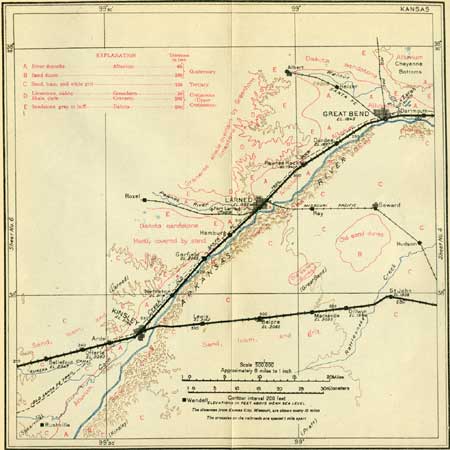
|
Geological Survey Bulletin 613
Guidebook of the Western United States: Part C. The Santa Fe Route |
ITINERARY
|
Kinsley. Elevation 2,164 feet. Population 1,547. Kansas City 332 miles.1 |
At Kinsley, named for W. E. W. Kinsley, of Boston, the old main line of the Santa Fe by way of Great Bend is joined by the cut-off or Hutchinson branch, described on pages 28-30. West of Kinsley the railway continues its nearly direct course west, diverging from the valley of the Arkansas, and thus avoiding the southward bend of the river. The ascent to the surface of the Great Plains2 is so gradual as to be barely noticeable, for the valley slopes west of Kinsley are very gentle.
1The distances given in the side notes are those by the old main line. To get the distance traveled by way of the Ottawa and Hutchinson cut-offs 30 miles should be deducted from the figures given for Kinsley and stations beyond; the distance by way of Topeka and the Hutchinson branch can be ascertained by deducting 15 miles.
2The Great Plains, a part of which is crossed on the way to Dodge, are described in the footnote on page 29.

|
|
SHEET No. 5 (click on image for an enlargement in a new window) |
|
Offerle. Elevation 2,263 feet. Kansas City 340 miles. |
At milepost 324, about a mile east of Offerle, is an 8-foot cut showing exposures of brown loam with streaks of gravel, apparently a part of the deposit of Tertiary age which covers the Great Plains. The eastern edge of this loam appears to pass downward toward the east under the higher terrace deposits of the Arkansas Valley, which are of later age. Probably both lie on the Dakota sandstone. A short distance beyond milepost 329 are other small exposures of the gravelly loam in shallow railway cuts.
|
Bellefont. Elevation 2,347 feet. Kansas City 346 miles. |
West of Bellefont, between mileposts 331 and 332, and for half a mile west from milepost 332, are cuts in the brown sand containing white calcium carbonate concretions. Westward of these cuts the line gradually ascends on a very smooth surface typical of the Great Plains.
| <<< Previous | <<< Contents >>> | Next >>> |
bul/613/sec5.htm
Last Updated: 28-Nov-2006